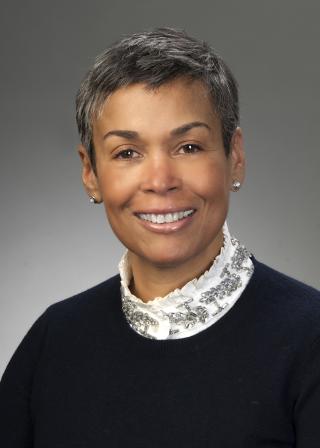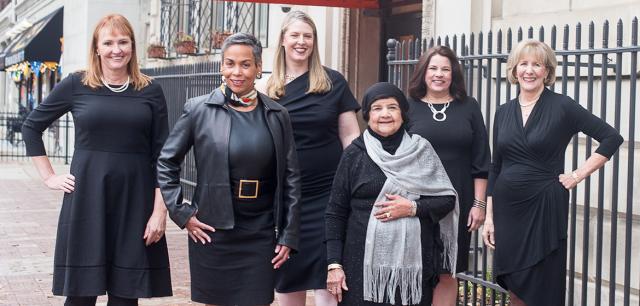
Bartley chosen as a 2019 YWCA Woman of Achievement
Congratulations to Trudy Bartley, associate vice president for community relations in the Office of Government Affairs, for being selected as a 2019 YWCA Woman of Achievement.

This award, which has been given to honor central Ohio women for more than 30 years, is granted to nominees who demonstrate a deep commitment to breaking down barriers and creating opportunities for women.
For more than 35 years, Trudy Bartley has developed the personal and professional leadership capacity of diverse women and has been an advocate for strengthening the economic and social fabric of communities of color in Columbus and the state of Ohio.
As deputy director for the City of Columbus, she formed a support group comprised of female directors and deputy directors. She made sure women on her team were promoted, and appropriately compensated, based on their experience and skill sets. In other roles, she actively sought women, as well as candidates of color, for open positions. She also helps women colleagues enhance their professional skills and is a mentor to many younger women throughout the city.

Bartley has a keen understanding of the intersection of racism, classism and sexism and is effective in challenging those social ills in a manner that does not demean or vilify others, making her a strong and powerful advocate in the struggle to eliminate racism and empower all women.
The Women's Place asked Bartley the following questions to learn how she achieved her leadership role at the university and what advice she has for other women who are working to advance.
Note: Responses have been lightly edited for length and style.
Which personal/career accomplishments are you most proud of, and why?
I am most proud of the opportunity provided by my work at OSU to assist in the revitalization of the Partners Achieving Community Transformation (PACT) neighborhood [which is the Near East Side of Columbus]. I grew up in the neighborhood; my father had his dental practice there; my mother taught at Fair Avenue in close proximity; and my brother was a police officer in the area. This is a neighborhood that raised me to be the person I am today.
In my youth it was a vibrant African American neighborhood offering services, retail, commerce, great schools, and a sense of community and where a majority of families owned their homes. Franklin Park was my backyard — where my friends and I played and families and friends gathered during summer weekends for reunions, barbeques and just riding around the park in their cars. There were also annual community activities on the Fourth of July and Christmas. It was a place of 45,000 people of all socioeconomic backgrounds until the freeway cut the neighborhood off from downtown.
But in 2012 when I started my work in PACT the neighborhood population was only 7000. After working on the Near East Side neighborhood for four years, we produced a master planning document with the residents; applied and received both a Choice Neighborhood Planning ($300K) and a Choice Neighborhood Implementation grant ($30M); created and implemented a partnership with Columbus Public Schools; reimagined the Poindexter Village development to become Poindexter Place; and implemented many other efforts which are still ongoing.
I am very proud and honored that I have been given the opportunity, through my work at Ohio State, to give back to a neighborhood that raised me and gave me so much.
Aside from the obvious hard work and dedication, is there anything else you attribute your career success at Ohio State to?
I attribute my success to working with visionary senior leaders who have allowed me and those I work with to be innovative and explore opportunities and partnerships that have not existed before. These leaders have given me the leeway to make decisions, which I believe support the land grant mission in providing resources for the betterment of town and gown partnerships with public and private organizations and non-profits. They trust me to represent Ohio State’s best interests on boards and commissions. I also attribute my success to rigorous and insightful discussions I have had with my peers that have assisted in my personal and professional growth.
What does it mean to you to be a YWCA Woman of Achievement?
I have always flourished in the company of women … from attending Columbus School for Girls from kindergarten through twelfth grade and then attending Wellesley College. Women have given me wisdom and encouragement to be the best I could be. It is such an honor to be recognized as a Woman of Achievement for I stand on the shoulders of prior Women of Achievement who have guided me along my personal and professional development. I operate on a standard of accountability and excellence that they have taught and expected of me. To be recognized for the work that I love … is humbling, and I am thankful for their and OSU’s belief in me to carry forward the mission of the betterment of all people in Ohio.
What advice would you give to other women looking to advance their careers at Ohio State?
I would advise women in general to never wait to be asked what they want the next step in their career to be but to pursue their goals and to work toward whatever their idea of success is … but to also be patient in getting there.
It is rare for a person to accomplish their dream of success overnight … it takes time, patience, loyalty, listening and relationships because nothing you achieve is on your own, it is with the assistance of others.
How can we empower women to seek leadership roles at the university?
My advice is to manage your own success, do not leave it entirely in the hands of others. Be bold but diplomatic in your approach as well as accept criticism and failure graciously. I have accomplished my greatest achievements after a failure because I learned from the occasion and understood how to assess my future approach for a different outcome.
What would you like to see for the future of women at Ohio State?
I would like to see more intentional intersectionality of women from both the academic, research and administrative (staff) side for community collaborations and partnerships. I believe women are great analysts, strategists and implementers. So if we intentionally work with each other on the academic, research, and community and engagement sides of opportunities … there is no limit to the positive disruption and change we could effect in the city, state, nation and internationally.